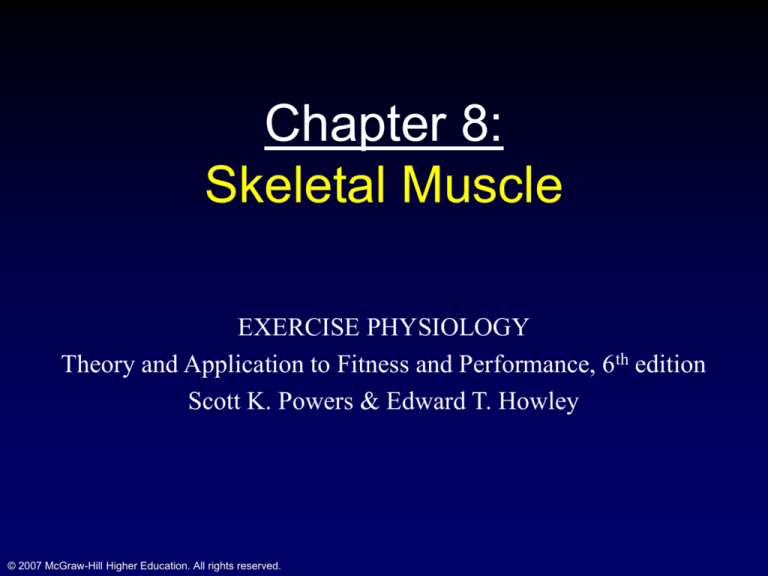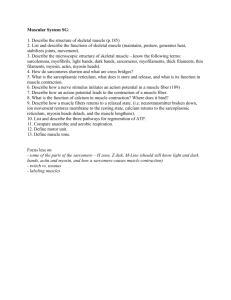
Chapter 8:
Skeletal Muscle
EXERCISE PHYSIOLOGY
Theory and Application to Fitness and Performance, 6th edition
Scott K. Powers & Edward T. Howley
© 2007 McGraw-Hill Higher Education. All rights reserved.
Objectives
• Draw & label the microstructure of skeletal
muscle
• Outline the steps leading to muscle
shortening
• Define the concentric and isometric
• Discuss: twitch, summation & tetanus
• Discus the major biochemical and mechanical
properties of skeletal muscle fiber types
© 2007 McGraw-Hill Higher Education. All rights reserved.
Objectives
• Discuss the relationship between skeletal
muscle fibers types and performance
• List & discuss those factors that regulate the
amount of force exerted during muscular
contraction
• Graph the relationship between movement
velocity and the amount of force exerted during
muscular contraction
• Discuss structure & function of muscle spindle
• Describe the function of a Golgi tendon organ
© 2007 McGraw-Hill Higher Education. All rights reserved.
Skeletal Muscle
• Human body contains over 400 skeletal muscles
– 40-50% of total body weight
• Functions of skeletal muscle
– Force production for locomotion and breathing
– Force production for postural support
– Heat production during cold stress
© 2007 McGraw-Hill Higher Education. All rights reserved.
Connective Tissue Covering
Skeletal Muscle
• Epimysium
– Surrounds entire muscle
• Perimysium
– Surrounds bundles of muscle fibers
• Fascicles
• Endomysium
– Surrounds individual muscle fibers
© 2007 McGraw-Hill Higher Education. All rights reserved.
Connective
Tissue
Covering
Skeletal
Muscle
Fig 8.1
© 2007 McGraw-Hill Higher Education. All rights reserved.
Microstructure of
Skeletal Muscle
• Sarcolemma: Muscle cell membrane
• Myofibrils Threadlike strands within muscle
fibers
– Actin (thin filament)
– Myosin (thick filament)
– Sarcomere
• Z-line, M-line, H-zone, A-band & I-band
© 2007 McGraw-Hill Higher Education. All rights reserved.
Microstructure
of Skeletal
Muscle
Fig 8.2
© 2007 McGraw-Hill Higher Education. All rights reserved.
Microstructure of
Skeletal Muscle
• Within the sarcoplasm
– Sarcoplasmic reticulum
• Storage sites for calcium
– Transverse tubules
– Terminal cisternae
– Mitochondria
© 2007 McGraw-Hill Higher Education. All rights reserved.
Within the
Sarcoplasm
Fig 8.3
© 2007 McGraw-Hill Higher Education. All rights reserved.
The Neuromuscular Junction
• Where motor neuron meets the muscle
fiber
• Motor end plate: pocket formed around
motor neuron by sarcolemma
• Neuromuscular cleft: short gap
• Ach is released from the motor neuron
– Causes an end-plate potential (EPP)
• Depolarization of muscle fiber
© 2007 McGraw-Hill Higher Education. All rights reserved.
Neuromuscular Junction
Fig 8.4
© 2007 McGraw-Hill Higher Education. All rights reserved.
Muscular Contraction
• The sliding filament model
– Muscle shortening occurs due to the
movement of the actin filament over the
myosin filament
– Formation of cross-bridges between actin
and myosin filaments “Power stroke”
• 1 power stroke only shorten muscle 1%
– Reduction in the distance between Z-lines
of the sarcomere
© 2007 McGraw-Hill Higher Education. All rights reserved.
The Sliding Filament Model
Fig 8.5
© 2007 McGraw-Hill Higher Education. All rights reserved.
Actin & Myosin Relationship
• Actin
– Actin-binding site
– Troponin with calcium binding site
– Tropomyosin
• Myosin
– Myosin head
– Myosin tais
© 2007 McGraw-Hill Higher Education. All rights reserved.
Actin & Myosin Relationship
© 2007 McGraw-Hill Higher Education. All rights reserved.
Fig 8.6
Energy for Muscle Contraction
• ATP is required for muscle contraction
– Myosin ATPase breaks down ATP as fiber
contracts
• Sources of ATP
– Phosphocreatine (PC)
– Glycolysis
– Oxidative phosphorylation
© 2007 McGraw-Hill Higher Education. All rights reserved.
Sources of ATP for Muscle
Contraction
Fig 8.7
© 2007 McGraw-Hill Higher Education. All rights reserved.
Excitation-Contraction
Coupling
• Depolarization of motor end plate (excitation)
is coupled to muscular contraction
– Nerve impulse travels down T-tubules and
causes release of Ca++ from SR
– Ca++ binds to troponin and causes position
change in tropomyosin, exposing active
sites on actin
– Permits strong binding state between actin
and myosin and contraction occurs
© 2007 McGraw-Hill Higher Education. All rights reserved.
ExcitationContraction
Coupling
Fig 8.9
© 2007 McGraw-Hill Higher Education. All rights reserved.
Steps Leading to Muscular
Contraction
Fig 8.10
© 2007 McGraw-Hill Higher Education. All rights reserved.
Properties of
Muscle Fiber Types
• Biochemical properties
– Oxidative capacity
– Type of ATPase
• Contractile properties
– Maximal force production
– Speed of contraction
– Muscle fiber efficiency
© 2007 McGraw-Hill Higher Education. All rights reserved.
Individual Fiber Types
Fast fibers
• Type IIx fibers
– Fast-twitch fibers
– Fast-glycolytic
fibers
• Type IIa fibers
– Intermediate
fibers
– Fast-oxidative
glycolytic fibers
© 2007 McGraw-Hill Higher Education. All rights reserved.
Slow fibers
• Type I fibers
– Slow-twitch fibers
– Slow-oxidative
fibers
Muscle Fiber Types
Fast Fibers
Slow fibers
Characteristic
Type IIx
Type IIa
Type I
Number of mitochondria
Low
High/mod
High
Resistance to fatigue
Low
High/mod
High
Predominant energy system
Anaerobic
Combination
Aerobic
ATPase
Highest
High
Low
Vmax (speed of shortening)
Highest
Intermediate
Low
Efficiency
Low
Moderate
High
Specific tension
High
High
Moderate
© 2007 McGraw-Hill Higher Education. All rights reserved.
Comparison of Maximal
Shortening Velocities Between
Fiber Types
Type IIx
Fig 8.11
© 2007 McGraw-Hill Higher Education. All rights reserved.
Histochemical Staining of Fiber
Type
Type IIa
Type IIx
Type I
Fig 8.12
© 2007 McGraw-Hill Higher Education. All rights reserved.
Fiber Typing
• Gel electrophoresis: myosin isoforms
– different weight move different distances
+
1 2 3 4 5
Type I
Type IIA
Type IIx
_
© 2007 McGraw-Hill Higher Education. All rights reserved.
1 – Marker
2 – Soleus
3 – Gastroc
4 – Quads
5 - Biceps
Table 10.2
Fiber Typing
• Immunohistochemical:
– Four serial slices of muscle tissue
– antibody attach to certain myosin isoforms
© 2007 McGraw-Hill Higher Education. All rights reserved.
Muscle Tissue: Rat Diaphragm
Type 1 fibers - dark
antibody: BA-D5
Type 2x fibers - light/white
antibody: BF-35
© 2007 McGraw-Hill Higher Education. All rights reserved.
Type 2b fiber - dark
Antibody: BF-F3
Type 2a fibers - dark
antibody: SC-71
Fiber Types and Performance
• Power athletes
– Sprinters
– Possess high percentage of fast fibers
• Endurance athletes
– Distance runners
– Have high percentage of slow fibers
• Others
– Weight lifters and nonathletes
– Have about 50% slow and 50% fast fibers
© 2007 McGraw-Hill Higher Education. All rights reserved.
Alteration of Fiber Type by
Training
• Endurance and resistance training
– Cannot change fast fibers to slow fibers
– Can result in shift from Type IIx to IIa fibers
• Toward more oxidative properties
© 2007 McGraw-Hill Higher Education. All rights reserved.
Training-Induced Changes in
Muscle Fiber Type
Fig 8.13
© 2007 McGraw-Hill Higher Education. All rights reserved.
Age-Related Changes in
Skeletal Muscle
• Aging is associated with a loss of muscle
mass
– Rate increases after 50 years of age
• Regular exercise training can improve
strength and endurance
– Cannot completely eliminate the agerelated loss in muscle mass
© 2007 McGraw-Hill Higher Education. All rights reserved.
Types of Muscle Contraction
• Isometric
– Muscle exerts force without changing length
– Pulling against immovable object
– Postural muscles
• Isotonic (dynamic)
– Concentric
• Muscle shortens during force production
– Eccentric
• Muscle produces force but length
increases
© 2007 McGraw-Hill Higher Education. All rights reserved.
Isotonic and Isometric
Contractions
Fig 8.14
© 2007 McGraw-Hill Higher Education. All rights reserved.
Speed of Muscle Contraction
and Relaxation
• Muscle twitch
– Contraction as the result of a single stimulus
– Latent period
• Lasting only ~5 ms
– Contraction
• Tension is developed
• 40 ms
– Relaxation
• 50 ms
© 2007 McGraw-Hill Higher Education. All rights reserved.
Muscle Twitch
Fig 8.15
© 2007 McGraw-Hill Higher Education. All rights reserved.
Force Regulation in Muscle
• Types and number of motor units recruited
– More motor units = greater force
– Fast motor units = greater force
– Increasing stimulus strength recruits more &
faster/stronger motor units
• Initial muscle length
– “Ideal” length for force generation
• Nature of the motor units neural stimulation
– Frequency of stimulation
• Simple twitch, summation, and tetanus
© 2007 McGraw-Hill Higher Education. All rights reserved.
Relationship Between
Stimulus Frequency and
Force Generation
Fig 8.16
© 2007 McGraw-Hill Higher Education. All rights reserved.
LengthTension
Relationship
Fig 8.17
© 2007 McGraw-Hill Higher Education. All rights reserved.
Simple Twitch, Summation,
and Tetanus
Fig 8.18
© 2007 McGraw-Hill Higher Education. All rights reserved.
Force-Velocity Relationship
• At any absolute force the speed of movement
is greater in muscle with higher percent of
fast-twitch fibers
• The maximum velocity of shortening is
greatest at the lowest force
– True for both slow and fast-twitch fibers
© 2007 McGraw-Hill Higher Education. All rights reserved.
Force-Velocity Relationship
© 2007 McGraw-Hill Higher Education. All rights reserved.
Fig 8.19
Force-Power Relationship
• At any given velocity of movement the power
generated is greater in a muscle with a higher
percent of fast-twitch fibers
• The peak power increases with velocity up to
movement speed of 200-300
degrees•second-1
– Force decreases with increasing
movement speed beyond this velocity
© 2007 McGraw-Hill Higher Education. All rights reserved.
Force-Power Relationship
• At any given velocity of movement the power
generated is greater in a muscle with a higher
percent of fast-twitch fibers
• The peak power increases with velocity up to
movement speed of 200-300 degrees/sec
– Force decreases with increasing
movement speed beyond this velocity
© 2007 McGraw-Hill Higher Education. All rights reserved.
Force-Power Relationship
Fig 8.20
© 2007 McGraw-Hill Higher Education. All rights reserved.
Receptors in Muscle
• Muscle spindle
– Changes in muscle length
– Rate of change in muscle length
– Intrafusal fiber contains actin & myosin, and
therefore has the ability to shorten
– Gamma motor neuron stimulate muscle spindle
to shorten
• Stretch reflex
– Stretch on muscle causes reflex contraction
© 2007 McGraw-Hill Higher Education. All rights reserved.
Muscle Spindle
Fig 8.21
© 2007 McGraw-Hill Higher Education. All rights reserved.
Receptors in Muscle
• Golgi tendon organ (GTO)
– Monitor tension developed in muscle
– Prevents damage during excessive force
generation
• Stimulation results in reflex relaxation of
muscle
© 2007 McGraw-Hill Higher Education. All rights reserved.
Golgi Tendon Organ
Fig 8.22
© 2007 McGraw-Hill Higher Education. All rights reserved.
Chapter 8:
Skeletal Muscle
© 2007 McGraw-Hill Higher Education. All rights reserved.








